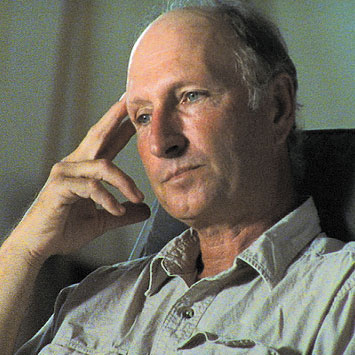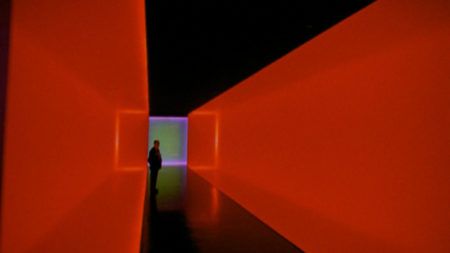Continue playing
(Time remaining: )
Play from beginning
Continue playing "{{ controller.videos[controller.getVideo(controller.currentVideo)].segmentParentTitle}}"
{{controller.videos[controller.getVideo(controller.currentVideo)].title}} has ended.
Identity
“Too often those who are quickest to assert their identity or loudest in proclaiming it have fastened on a single, supposedly fixed aspect of their nature or background to the detriment of the rest,” writes Robert Storr in an essay for the Art in the Twenty-First Century Companion Book. “Whatever the reasons for them, the work of the artists discussed here demonstrate the error and the futility of such ostensibly self-protective but in actuality self-restrictive measures.”
Credits
Created by: Susan Sollins & Susan Dowling. Executive Producer & Curator: Susan Sollins. Executive Producer: Susan Dowling. Series Producer: Eve-Laure Moros Ortega. Associate Producer: Migs Wright. Production Coordinator: Laura Recht. Researcher: Quinn Latimer & Wesley Miller. Director: Catherine Tatge. Editor: Donna Marino. Director of Photography: Bob Elfstrom, Mark Falstad, Tom Hurwitz, Terry Hopkins, & Ken Kobland. Assistant Camera: Doug Dunderdale & Steve Nealey. Sound: David Brownlow, Heidi Hesse, Mark Roy, Bill Wander, & Joe Yario. Gaffer/Grip: Lamar Bloodworth & Ned Hallick. Production Assistant: Steve Carrillo, Brian Hwang, Graham Gangi, Scott Stevens, Erick Michaud, Alexei Van Mourik, & Heather Murray. Animation Stand Photography: Marcos Levy & City Lights. Assistant Avid Editor: Matt Prinzig & Heather Burak. Assistant to the Director: Rachel Connolly.
Introductory Segment | Director & Writer: William Wegman. Producer: Andrea Beeman. Cast: Steve Martin, Jason Burch, Chip, Chundo. Director of Photography: Edgar Gil. Costumes: Pam Wegman. Editor: Steve Silkensen. Sound: Martin G. Cole, Marilys Ernst. On-Line Editor: Benton Bainbridge, DMZ. Post Mix: Danny Caccavo, Sync Sound.
Louise Bourgeois Segment | Producer/Editor: Marion Cajori. Associate Producer: Kipjaz Savoie. Director of Photography: Mead Hunt. Assistant Camera: Brian O’Caroll. Sound: Peter Miller. Production Assistant: Anya Popova.
Creative Consultant: Ed Sherin. Art Design and Direction: Open, New York. Animation, Visual Effects & Compositing: Spontaneous Combustion. On-Line Editor: Don Wyllie & Frame:Runner NYC. Composer: Peter Foley. Music Supervisor: John Yaffé. Sound Editing: Margaret Crimmins, Greg Smith, & Dog Bark Sound. Sound Mix: Tony Volante & Soundtrack, New York. Post-Production Supervisor: Michael Weingrad & Keir Randall.
Artworks courtesy of: Louise Bourgeois; Jerry Gorovoy; Maya Lin; Kerry James Marshall; © 2001 Bruce Nauman / Artists Rights Society (ARS), New York; Addison Gallery of American Art, Phillips Academy; Art Institute of Chicago; Art Kaleidoscope Foundation; Cheim & Read; Sarah Clark-Langager, Western Washington University; Donald Young Gallery; Gagosian Gallery; Jack Shainman Gallery; Museum of Contemporary Art, Chicago; South Eastern Center for Contemporary Art; Southern Poverty Law Center; Sperone Westwater Gallery; & Whitney Museum of American Art. Archival material courtesy of: Frey Foundation; Langston Hughes Library; Timothy Hursley; The Hull House; & Chicago Parks Department.
Special Thanks: Anne C. Baker; Alison Beall; Jamie Bennett; Joyce Bobolts; Brooklyn Museum; The Bruce Family; William Bush; City Lights; Susan Delson; Dennis Diamond; Dia Center for the Arts; David Ebner; Thomas G. Grace; Russell Hassell; Bruce Mac Corkindale; Cara Mertes; Margarita Moreno; Juliet Myers; Chris Pullman; Queens Museum; Tamberelli Video; University of Illinois, Chicago; Darin Webb; & Wendy Williams.
Interns: Maytal Ahrony, Joyce Alcantara, Christina Darcy, Leslie Fritz, Johanna Goldfeld, Susannah Gust, Sage Lehman, Kelly McCoy, Genevieve Mercatante, Jeff Seelbach, & Stacy Wu.
Public Relations: Kelly & Salerno Communications. Legal Counsel: Albert Gottesman.
Major underwriting for Season 1 of Art in the Twenty-First Century is provided by Robert Lehman Foundation, PBS, National Endowment for the Arts, Corporation for Public Broadcasting, Rockefeller Brothers Fund, Agnes Gund and Daniel Shapiro, The Allen Foundation for the Arts, The Broad Art Foundation, The Jon and Mary Shirley Foundation, Bagley Wright Fund, The Rockefeller Foundation, The Andy Warhol Foundation for the Visual Arts, The Horace W. Goldsmith Foundation, and The Foundation-to-Life.
Closed captionsAvailable in English, German, Romanian, Italian, Japanese, Korean, Chinese, Italian
Through the Art21 Translation Project, multilingual audiences from around the globe can contribute translations, making Art21 films more accessible worldwide.
Interested in showing this film in an exhibition or public screening? To license this video please visit Licensing & Reproduction.
Bruce Nauman was born in 1941 in Fort Wayne, Indiana, and currently lives and works near Galisteo, New Mexico. He graduated with a BFA from the University of Wisconsin, Madison, in 1964, and with an MFA from the University of California, Davis, in 1966. In his work, Nauman uses videos, sculptures, holograms, neon lights, and installations to create scenarios that disrupt viewers’ habits of perception. By investigating themes of time, control, and language, the artist creates an open-ended body of work that prioritizes process over product and expands the possibilities of what art may be.
Kerry James Marshall was born in 1955 in Birmingham, Alabama, and currently lives and works in Chicago, Illinois. The artist was educated at Otis Art Institute, where he received a BFA in 1978 and an honorary doctorate in 1999. In his work, Marshall interrogates Western art history, recontextualizing the canon to include themes and imagery that have been historically excluded. Through his paintings, drawings, installations, and public works, the artist builds a body of work that privileges the Black figure, using race, history, and everyday Black experiences as the inspiration for his work.
Louise Bourgeois was born in Paris in 1911. She first studied mathematics at Sorbonne University before pursuing a degree in arts at various schools around Paris, including the Ecole du Louvre, Académie des Beaux-Arts, Académie Julian, and Atelier Fernand Léger. In 1938, she immigrated to the United States, continued her studies at the Art Students League in New York, and began making sculptures on the roof of her apartment. Bourgeois’s early sculptures were composed of groupings of abstract shapes, often carved from wood. By the 1960s, the artist began to execute her work in rubber, bronze, and stone, and the pieces themselves became larger and more referential to what has become the dominant themes of her work: her childhood, familial trauma, and loneliness.
Maya Lin was born in 1959 in Athens, Ohio, and currently lives and works in New York City. She attended Yale University, where she received her bachelor’s degree in 1981 in art and architecture and her M.Arch. in 1986. Trained as an architect and an artist, Lin’s work encompasses memorial designs, architectural works, and large-scale environmental installations. Using water and natural landscapes as a throughline between her disparate practices, Lin’s work touches on themes of memory and time, exploring how we experience and relate to our environment and surroundings.
William Wegman’s interests in areas beyond painting led him to photography and the then-infant medium of video. A central figure in his photography and videos, Wegman’s dog Man Ray became known in the art world and beyond for his endearing, deadpan presence. In 1972, Wegman and Man Ray moved to New York. In 1986, a new dog, Fay Ray, came into Wegman’s life; and soon thereafter another famous collaboration began, marked by Wegman’s use of the Polaroid 20-by-24-inch camera. With the birth of Fay’s litter in 1989 and her daughter’s litter in 1995, Wegman’s cast of characters grew.
“I needed a different way to approach the idea of being an artist.”
Bruce Nauman






